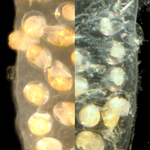ESHAP
 |
Evolution of Self-fertilisation in Hermaphrodites, an Animal Perspective |
|
Research
Context and Issues
ESHAP is a basic research project addressing a fundamental question in evolution: How does self-fertilization (“selfing”) evolve and what are its evolutionary consequences? This question is one of the oldest in evolutionary biology. However, while the theory is becoming more refined, some of its most basic ideas remain insufficiently tested. One of the striking gaps in our knowledge is the paucity of data on animals, as compared to angiosperms, although most animal phyla also contain predominantly hermaphroditic groups.
In this project, we argue that animals should be studied in more detail for two reasons:
- they offer an evolutionary replicate for the study of mating systems and hence will allow assessment of the degree of generality of results obtained for angiosperms
- they are more appropriate than angiosperms for experimental evolution, which requires raising fast-reproducing organisms over many generations.
Objectives
ESHAP focuses on a group of freshwater snails (basommatophorans) with highly diverse mating systems to investigate evolutionary transitions between outcrossing and selfing, and to test, in particular, the long-standing hypothesis that selfing is an evolutionary dead-end.
Methodology
The dead-end hypothesis is tested in two ways:
- Characterisation of the number and unidirectionality of transitions in the phylogeny
- Empirical test of the key steps of the most plausible scenario describing how an outcrossing species can become a preferential selfer.
- constraints on mate or pollen availability resulting in a selection for selfing as a reproductive insurance
- the existence of an intermediate state of preferential outcrossing with delayed, optional selfng when mates are lacking
- the purging of inbreeding depression, resulting in runaway selection for selfing and even less inbreeding depression
- the lack of adaptive potential in selfers, resulting in high extinction rates.
Results
Among the expected breakthroughs of this project will be the first experimental-evolution study of mating system evolution and the first unbiased estimates of the frequency of mixed-mating in animals. This will meet our objective to establish animals, and especially basommatophoran snails, as essential models for mating system theory.
People involved
 |
BESNARD Anne-Laure, Technician Phone : +33 2 23 48 54 43 Email : anne-laure.besnard(at)inrae.fr |
 |
COLLINET Marc, Technician Phone : +33 2 23 48 55 29 Email : marc.collinet@inrae.fr |
 |
COUTELLEC Marie-Agnès, Scientist Phone : +33 2 23 48 52 48 Email : marie-agnes.coutellec@inrae.fr |
Partners
Funding and Support
ANR The french National Research Agency
